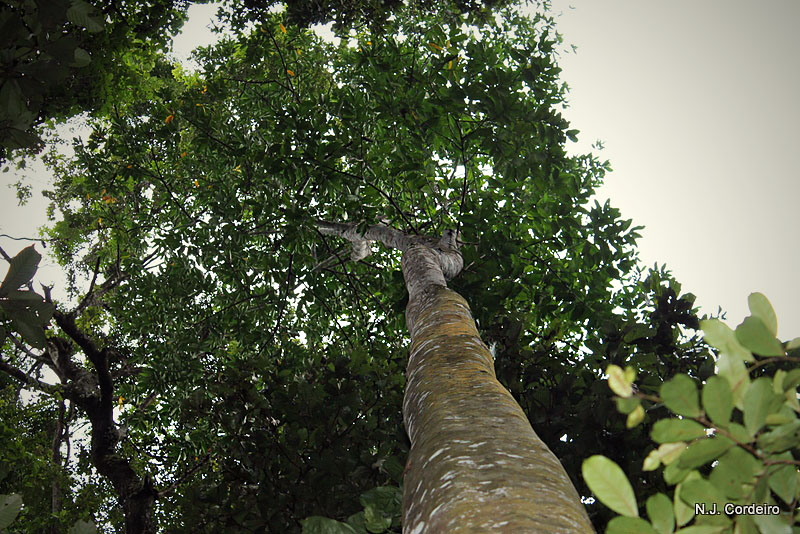Funtumia africana

|
|
Funtumia Africana Common Names: Male
Funtum, African Rubber Tree Scientific
Classification Kingdom: Plantae Clade: Tracheophytes Clade: Angiosperms Clade: Eudicots Clade: Asterids Order: Gentianales Family: Apocynaceae Genus: Funtumia Species: F. africana Synonyms: Tombea
africana (Benth.) Kuntze. Morphological Description Funtumia africana is a tall, evergreen tree
that typically reaches heights of 15–30 meters, though exceptional specimens
may grow taller in undisturbed forests. Its key morphological features include: · Bark: Rough,
greenish-brown to grey, often smooth in younger trees, becoming fissured with
age; exudes a milky latex when cut. · Leaves: Simple,
opposite, elliptic to lanceolate (5–32 cm long, 1.7–17 cm wide), glossy dark
green, leathery, with an acuminate apex and cuneate base; petioles 3–15 mm
long. · Flowers: Creamy-yellow,
fragrant, bisexual, arranged in terminal or axillary cymes; corolla tubular,
5-lobed, approximately 1–2 cm long. · Fruit: Fusiform
follicles (15–25 cm long), grey-brown, containing numerous flat, winged seeds
with silky hairs facilitating wind dispersal. The tree’s straight, cylindrical trunk may develop buttress roots
in mature specimens, enhancing stability in rainforest environments (Omino,
2002). Distribution and Habitat Funtumia africana is native to tropical
West and Central Africa, spanning latitudes from 10°N to 15°S. It is documented
in: · West Africa: Nigeria,
Ghana, Côte d’Ivoire, Sierra Leone (annual rainfall 1,500–3,000 mm). · Central Africa: Cameroon,
Democratic Republic of Congo, extending southwards to Mozambique (altitude
0–1,500 m). It thrives in humid lowland rainforests, gallery forests, and
secondary forests, preferring well-drained, loamy soils with a pH of 5.0–6.5.
The species is shade-tolerant in its juvenile stages, making it a common
understory tree before maturing into the canopy (Akoègninou et al., 2006). Ethnopharmacology Funtumia africana holds significant value
in West African traditional medicine, with various parts used to treat a range
of ailments. The roots are traditionally pounded and mixed with palm-wine and
water to treat urinary incontinence, and a root decoction is used for amoebic
dysentery. The dried powdered leaves are applied to treat burns. The tree
contains several alkaloids, including funtumine and funtumidine, which are
hypotensive and locally anesthetic. These compounds are also precursors to
steroidal hormones. Ethnopharmacological studies support these uses: · Respiratory Conditions: Bark
decoctions are widely used in Nigeria and Ghana to treat coughs, bronchitis,
and asthma. Ramadwa et al. (2017) found that leaf extracts exhibit
anti-inflammatory activity, reducing nitric oxide production by 45% in
LPS-stimulated RAW 264.7 cells, supporting its use in respiratory inflammation. · Antimicrobial
Properties: The latex and bark are traditionally applied to wounds and
infections. A study by Adekunle and Ikumapayi (2006) confirmed that ethanol
extracts of the leaves inhibit Staphylococcus
aureus and Escherichia
coli with MIC values of 50–100 μg/ml, validating antimicrobial
claims. · Antimalarial Activity: In
Côte d’Ivoire, bark infusions are used against malaria. · Pain and Fever Relief: Leaf
poultices are applied for pain and fever in Cameroon. The presence of conanine
and related alkaloids may contribute to analgesic effects, though specific
studies on this are limited (Burkill, 1985). Phytochemical analyses reveal steroidal alkaloids (e.g., conanine,
funtumine) and triterpenoids in the bark and leaves, which likely underpin its
bioactivity (Ramadwa et al., 2017). ⚠ Toxicity Profile: The
milky latex of Funtumia
africana is irritant to skin and eyes and has been used
traditionally as an arrow poison by the Guere people of Côte d’Ivoire. High
doses of bark extracts (>2,000 mg/kg) in rodent studies showed mild hepatotoxicity,
suggesting caution in prolonged use (Adekunle & Ikumapayi, 2006). Additional Information
References
External Links More Pictures |
|
| Compounds of Funtumia africana | |
| References |